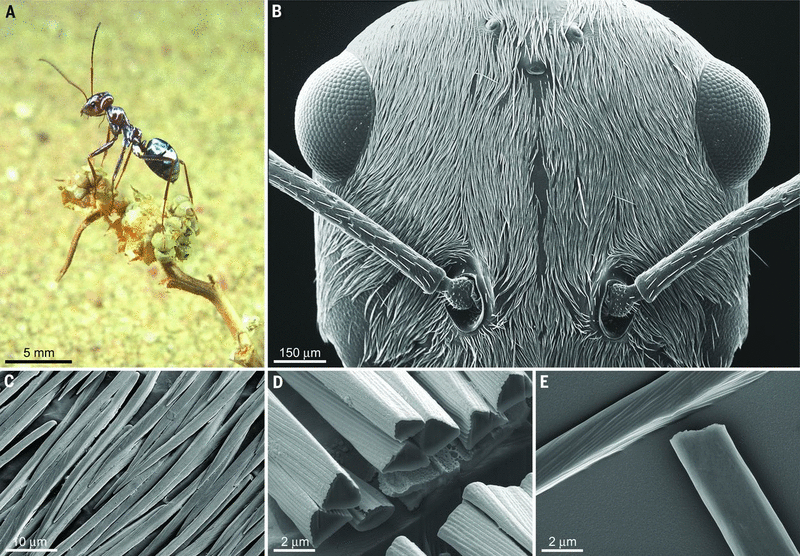That is the question that was asked by an audience to the famous TV show in Korea: Curiosity Heaven, ie. “paradise for curiosity“. This program has been premiered since the 1990s, in which the producer will do his own experiments or consult experts to find answers to all the weirdest questions in the world.
For the question of the death of an ant when jumping off a skyscraper, Curiosity Heaven actually did an experiment to find out. They brought the ants to the roof of 63 Building, a 63-storey building 449 meters high in the capital Seoul to drop them:


Regrettably, the tape that archived the show ended up not being available on the internet for us to review. Some viewers with only a vague memory of it said: The ants were dropped from the 63rd floor, but Curiosity Heaven has no way to find them to confirm whether it is alive or dead.
So that mystery continues to stimulate the curiosity of many people. It even spread to the United States, with another version in the “Ask the Van” column of the Department of Physics, University of Illinois: “If I drop an ant from the top of the Empire State Building, will it be killed on impact, or will the resistance of the air flow bring it safely to the ground?”
There’s also a thread on r/askcience on Reddit that discusses this question. However, we don’t really need to repeat the experiment, bringing an ant to the 63rd floor of a building to drop it to confirm its life and death status.
Perhaps, this will also be strongly opposed by the Fight for Animal Ethics (PETA). So let’s work on a bit of theory here, to see if physics can kill an ant dropped from the 63rd floor.

It depends on the final velocity of the free fall
In order to know how much damage a free fall can do to an ant, we need to evaluate the force it exerts on it when it hits the ground. Basically, when you release an ant from a tall building, there will be 2 forces acting on it.
The first is that gravity depends on the acceleration due to gravity (9.8 N/kg on Earth) and the mass of the ant. The other force is air resistance. Air resistance increases with the speed of the ant during the fall and always pushes in the opposite direction of its motion.
If we assume that the ant just falls vertically downwards, the equation for the sum of the forces acting on it will be:
Neglecting the constants (air density), A (ant cross-sectional area) and C (shape-dependent drag), we see that as the velocity v increases, to a threshold Somehow, air resistance will cancel out gravity. Then the total force acting on the ant will be zero. The ant will fall at a constant speed, we call that the terminal velocity.
End velocity is defined as the steady speed of an object in free fall in a gas or liquid. The greater the weight and size of an object, the greater its final velocity.
This means that when it hits the ground, a larger jet is generated. If the subject is a living organism, a greater velocity means a lower chance of survival, and vice versa.

Take humans as an example. When a person parachutes and free falls, he can reach a terminal speed of about 200 km/h in 15 seconds and a distance of 450 meters. If we don’t launch our parachute to land at this speed, we will definitely die.
A cat, with a smaller body, can only reach a final speed of 97 km/h. The distance they traveled was only 18-21 meters. Therefore, statistics show that the survival rate of a cat falling from the 7th floor to the floors above it is the same, because they have all reached their terminal velocity.
In fact, a cat fell from a 32nd floor window of a building onto a New York street with only a broken rib and a collapsed lung. For cats, this injury equates to just two days in the hospital before being able to go home.
Rats, have even smaller terminal velocities. John Burdon Sanderson Haldane, a British biologist, claims you can drop a mouse into a mine tunnel thousands of meters long. When it reached the bottom, it was only slightly shocked, then immediately regained consciousness and snuck away.
Why can cats survive a fall from the 32nd floor?
Haldane says any creature smaller than a mouse can survive a free fall from any distance. That’s because air resistance is directly proportional to the surface of the moving object.
“Divide an animal’s length, width, and height by 10, and its weight will drop to a thousandth, but its surface will only decrease by one percent. Therefore, the drop resistance in the case of a small object can be 10 times greater than the force exerted.”Haldane wrote.
The ants won’t die
In the case of an ant, “Ask the Van” of the Department of Physics, University of Illinois says it has a very small terminal velocity, no more than 2 m/s, or 7.2 km/h. At this terminal velocity, air resistance will easily lift captures the ant and slows its speed when it hits the ground.
The physical impact on the ant’s body is therefore negligible. It will stay alive and get up and walk around as usual.

In the case of a windy day, the convection of the air can even overcome gravity and blow the ant back up.
It is also a common phenomenon for small objects with small terminal velocities such as dust or fog. They can often stay suspended in the air forever without ever touching the ground.
It must be said that, whenever the ant reaches terminal velocity, altitude will no longer be an issue. So the survival rate of a free-falling ant from the 63rd floor is actually equivalent to that of falling from a treetop to the ground.
There was a German TV show, Die Sendung mit der Maus that did an experiment to test that, and you really don’t have to understand German to see the results:
What happens if you drop an ant from a tall building to the ground?
In the experiment, the ants were dropped from a relative height but were able to immediately get up and walk again. One reason for this is that ants have a structure with chitinous bones covering their bodies.
The sturdiness of the chitin layer not only protects the ants from falls from great heights, but also helps them lift heavy loads and fend off enemy attacks. This is in stark contrast to vertebrates like us, whose skeletons are located inside the body and need to be protected by layers of soft tissue.

In addition, studies have also shown that ants do not have pain receptors. That is, they do not feel any pain like humans and other higher animals.
Therefore, a fall from the 63rd floor to the ground for ants can be just a pleasant journey through the air. It won’t cause the ants any trouble, except having to find their way home. So that could be a little more reassuring for PETA, right?
Refer to Theverge
